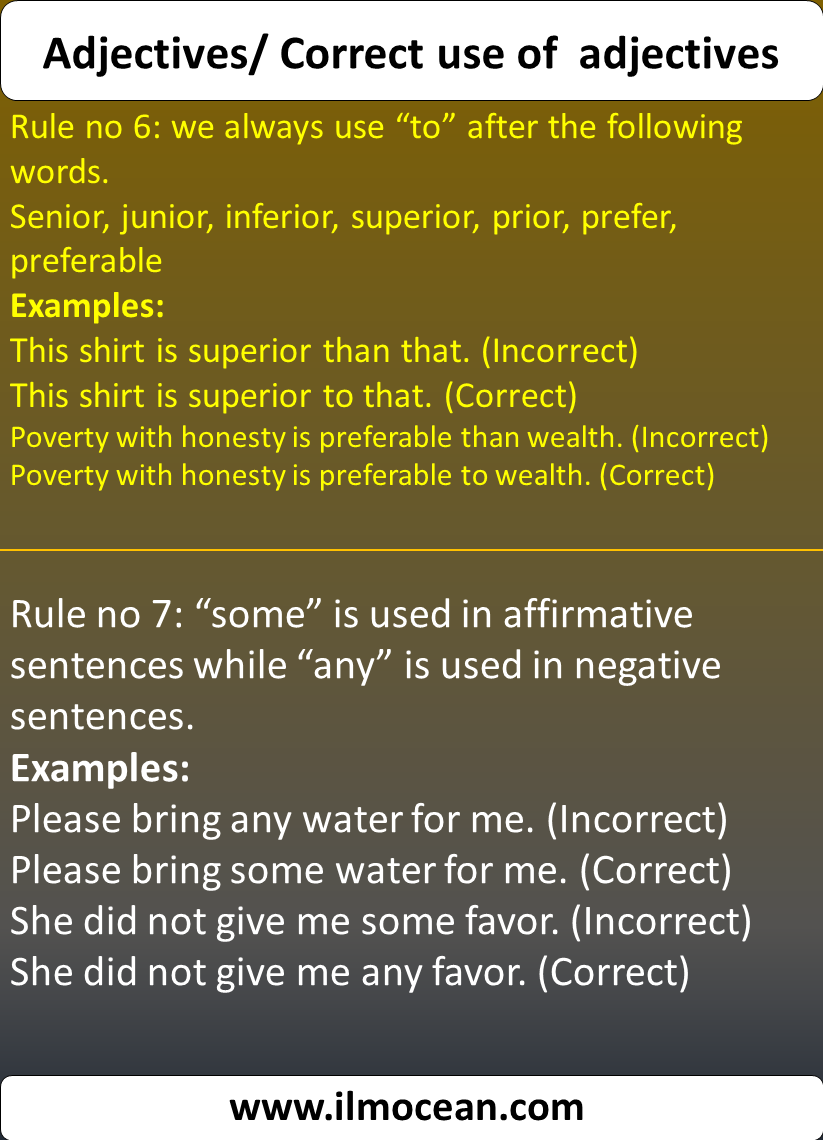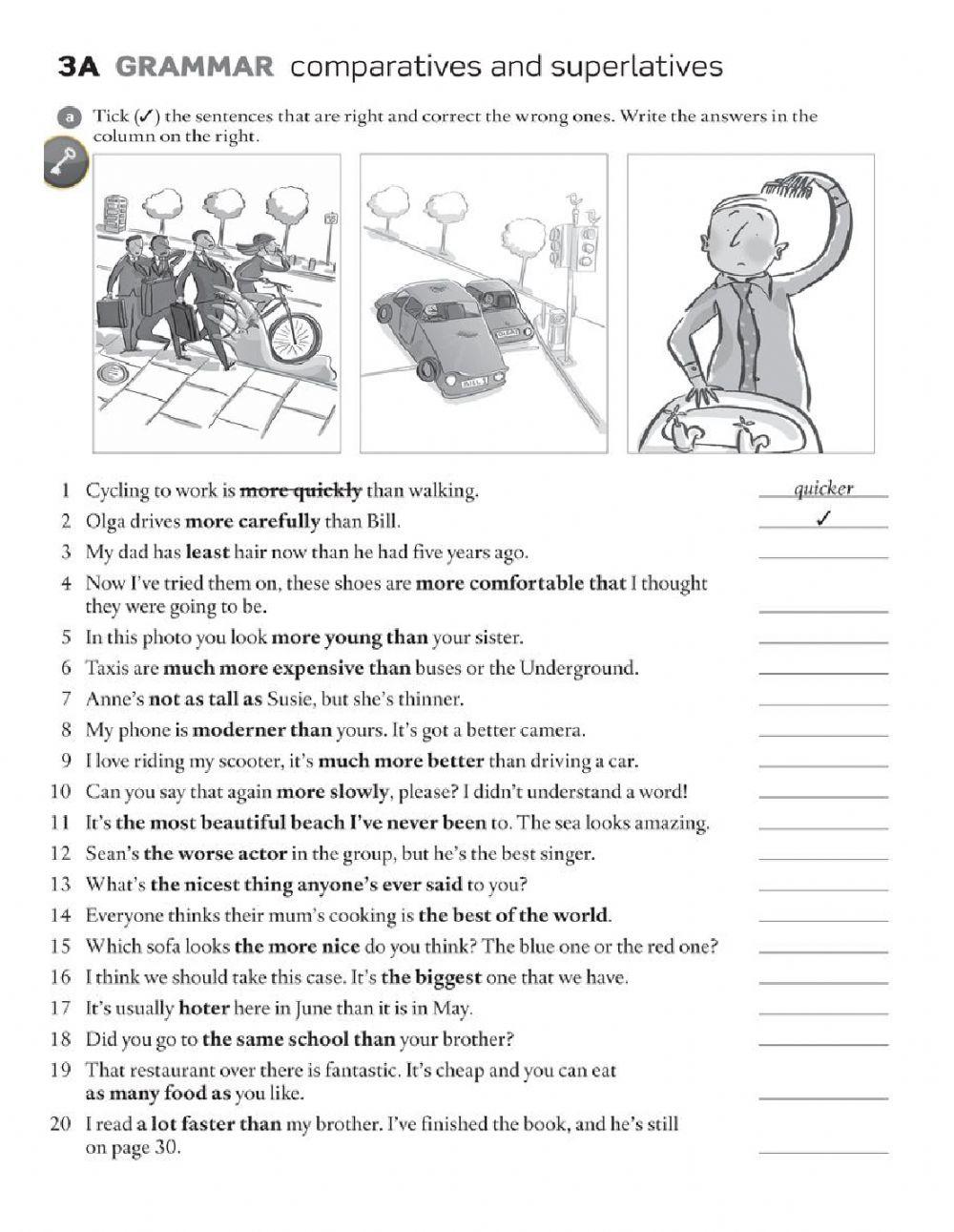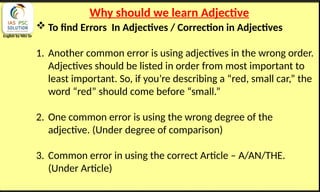
Mastering Precision: A Comprehensive Guide to Adjective Error Correction
In the vast and intricate landscape of the English language, adjectives serve as vital tools, painting vivid pictures and adding crucial detail to our communication. They allow us to differentiate, quantify, and qualify nouns and pronouns, transforming bland statements into rich, descriptive narratives. However, despite their fundamental role, adjectives are frequently a source of confusion and error for both native and non-native speakers. Misplaced modifiers, incorrect comparative forms, and the subtle interplay between adjectives and adverbs are just a few of the common pitfalls that can undermine clarity and professionalism in writing.
This article delves deep into the intricacies of adjective usage, identifying common pitfalls and offering practical strategies for effective adjective error correction. By understanding the nuances of these descriptive words and committing to careful revision, writers can significantly enhance the precision, impact, and overall quality of their communication.
The Role of Adjectives: More Than Just Decoration

Before diving into errors, it’s essential to grasp the core function of adjectives. An adjective is a word that modifies a noun or pronoun. It answers questions like:
- Which one? (the red car)
- What kind? (a delicious meal)
- How many? (three books)
- How much? (much effort)



They add specificity and depth, allowing the reader or listener to form a clearer mental image. Without adjectives, our language would be remarkably dull and imprecise. Consider the difference between "He bought a house" and "He bought a spacious, old, brick house." The latter provides a wealth of information that the former lacks.
Common Adjective Errors and How to Spot Them

Effective adjective error correction begins with the ability to identify the various types of mistakes. Here are some of the most prevalent:
1. Misplaced Modifiers

One of the most common and often humorous errors involves placing an adjective (or adjective phrase/clause) in a position where it modifies the wrong noun. This can lead to awkward, illogical, or even comical sentences.
-
Incorrect: "She only ate one cookie." (Implies that eating was the only thing she did with the cookie, rather than eating just one).
-
Correct: "She ate only one cookie." (Clearly states the quantity).
-
Incorrect: "The dog was found in the park running quickly." (Suggests the park was running quickly).
-
Correct: "The dog, running quickly, was found in the park." or "The dog was found running quickly in the park."

Correction Strategy: Always place the adjective or adjective phrase as close as possible to the noun or pronoun it is intended to modify. If a modifier could logically apply to two different words, rephrase the sentence for absolute clarity.
2. Dangling Modifiers
Related to misplaced modifiers, a dangling modifier occurs when the word or phrase being modified is missing from the sentence. The modifier is "dangling" because it has nothing clear to attach to.
- Incorrect: "Running down the street, the car hit a pole." (Implies the car was running down the street).
- Correct: "Running down the street, I saw the car hit a pole." or "As I ran down the street, the car hit a pole."
Correction Strategy: Ensure that the subject performing the action described by the modifier is explicitly stated right after the modifier or within the main clause.
3. Incorrect Use of Comparative and Superlative Forms
Adjectives change form to show degrees of comparison.
- Positive: (e.g., tall)
- Comparative: used when comparing two things (e.g., taller)
- Superlative: used when comparing three or more things (e.g., tallest)
Common errors include:
- Double Comparatives/Superlatives: Using both "-er/-est" and "more/most."
- Incorrect: "He is more taller than his brother."
- Correct: "He is taller than his brother."
- Incorrect Form for Irregular Adjectives:
- Incorrect: "She sings gooder than him."
- Correct: "She sings better than him." (Good, better, best)
- Incorrect: "This is the baddest movie I’ve seen." (Unless used informally for emphasis)
- Correct: "This is the worst movie I’ve seen." (Bad, worse, worst)
- Comparing More Than Two with Comparative:
- Incorrect: "Between the two options, this one is the best."
- Correct: "Between the two options, this one is the better."
Correction Strategy: For most one or two-syllable adjectives, add "-er" for comparative and "-est" for superlative. For adjectives with three or more syllables, use "more" and "most." Memorize the irregular forms. Remember to use "than" with comparatives and "the" with superlatives.
4. Adjective vs. Adverb Confusion
This is perhaps one of the most frequent errors. Adjectives modify nouns/pronouns; adverbs modify verbs, adjectives, or other adverbs. Many adverbs end in "-ly."
-
Incorrect: "He writes good." (Good is an adjective, it cannot modify the verb "writes.")
-
Correct: "He writes well." (Well is an adverb, modifying "writes.")
-
Incorrect: "She felt badly about the news." (Unless her sense of touch was impaired. "Bad" here describes her emotional state).
-
Correct: "She felt bad about the news." (Verbs like "feel," "look," "smell," "sound," "taste," "be" are linking verbs and are followed by adjectives that describe the subject).
Correction Strategy: Determine what the word is modifying. If it describes a noun or pronoun, use an adjective. If it describes a verb, an adjective, or another adverb, use an adverb (often ending in -ly). Pay special attention to linking verbs, which always take adjectives.
5. Order of Adjectives
When multiple adjectives modify a single noun, they typically follow a specific order. While native speakers often do this instinctively, it can be challenging for others. The general order is: Determiner (a, the, my) > Opinion > Size > Age > Shape > Color > Origin > Material > Purpose > Noun. (A mnemonic like "DOSA-SCOMP" can help).
-
Incorrect: "She bought a red big old car."
-
Correct: "She bought a big old red car." (Size > Age > Color)
-
Incorrect: "He wore a leather new stylish jacket."
-
Correct: "He wore a stylish new leather jacket." (Opinion > Age > Material)
Correction Strategy: Learn and apply the conventional order of adjectives. Reading the sentence aloud can often help identify awkward phrasing that violates this order.
6. Hyphenated Compound Adjectives
When two or more words function as a single adjective before a noun, they are often hyphenated to avoid ambiguity.
-
Ambiguous: "He is a well known author." (Could mean he is well, and he is a known author).
-
Clear: "He is a well-known author." (Clearly indicates "known" in a "well" manner).
-
Incorrect: "She found a twenty year old man."
-
Correct: "She found a twenty-year-old man."
Correction Strategy: Hyphenate compound adjectives when they precede the noun they modify. If they come after the noun (e.g., "The author is well known"), no hyphen is usually needed.
7. Confusing Adjective Pairs
Many pairs of adjectives are frequently confused due to similar meanings or sounds, but have distinct uses.
-
Fewer vs. Less:
- Fewer: Used for countable nouns (e.g., fewer books, fewer people).
- Less: Used for uncountable nouns (e.g., less water, less time).
- Incorrect: "I have less problems today."
- Correct: "I have fewer problems today."
-
Many vs. Much:
- Many: Used for countable nouns (e.g., many ideas, many cars).
- Much: Used for uncountable nouns (e.g., much effort, much patience).
-
Historic vs. Historical:
- Historic: Refers to something important or famous in history (e.g., a historic moment).
- Historical: Refers to something related to history in general (e.g., a historical document, a historical novel).
Correction Strategy: Memorize the distinctions between commonly confused pairs. When in doubt, consult a dictionary or style guide.
Strategies for Effective Adjective Error Correction
Identifying errors is only half the battle; knowing how to correct them efficiently is equally important. This dedicated approach to adjective error correction significantly boosts accuracy and confidence.
-
Master the Rules: The most fundamental strategy is to understand the grammatical rules governing adjective usage. This article covers many, but continuous learning and reference to reliable grammar resources are key. Knowing why an error is an error empowers you to fix it and prevent it in the future.
-
Read Aloud: Reading your writing aloud forces you to slow down and hear the rhythm and flow of your sentences. Awkward phrasing, misplaced modifiers, and incorrect adjective-adverb usage often become glaringly obvious when spoken. Your ear can catch what your eye might miss.
-
Targeted Proofreading: Instead of reading for all errors at once, dedicate a specific pass of your proofreading process solely to adjectives. Ask yourself:
- Are all modifiers correctly placed?
- Are comparative and superlative forms used correctly?
- Are adjectives used where adverbs should be, or vice versa?
- Is the order of adjectives correct?
- Are compound adjectives hyphenated appropriately?
- Are there any confusing adjective pairs?
-
Leverage Grammar Tools (with Caution): Online grammar checkers (like Grammarly, ProWritingAid) and word processor spell/grammar checks can be helpful first-pass tools. However, they are not infallible. They often miss subtle errors, especially with misplaced modifiers or the nuanced distinction between "good" and "well." Use them as aids, not as definitive proofreaders. Always apply critical thinking.
-
Seek Peer Review: A fresh pair of eyes can often spot errors that you, the writer, have become blind to. Ask a trusted friend, colleague, or editor to review your work specifically for grammatical accuracy, including adjective usage.
-
Consistent Practice and Exposure: The more you read high-quality English texts and write regularly, the more intuitive correct adjective usage will become. Pay attention to how professional writers use adjectives. Engage in grammar exercises focusing on adjectives. Through consistent application of these strategies, writers can dramatically improve their skills in adjective error correction.
Conclusion
Adjectives are the unsung heroes of descriptive language, allowing us to convey precise meaning and evoke specific images. While their misuse can lead to ambiguity and diminish the quality of writing, mastering adjective error correction is an attainable goal for anyone committed to improving their communication skills.
By diligently applying the strategies outlined in this guide—understanding grammatical rules, employing targeted proofreading techniques, reading aloud, and leveraging helpful resources—writers can systematically eliminate common adjective errors. The journey toward impeccable writing is continuous, and mastering adjective error correction is a significant milestone that enhances clarity, strengthens arguments, and ultimately, makes your writing more impactful and professional. Embrace the nuances of language, and let your adjectives work effectively to paint the exact picture you intend.


